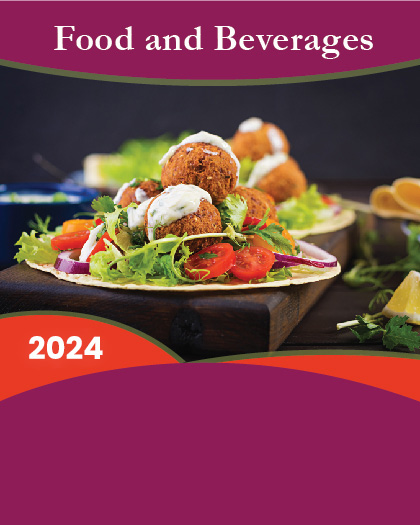1. Preface
1.1. Objectives of the Study
1.2. Market Segmentation & Coverage
1.3. Years Considered for the Study
1.4. Currency & Pricing
1.5. Language
1.6. Stakeholders
2. Research & Forecasting
2.1. Research Methodology
2.1.1. Research Process
2.1.2. Research Framework
2.1.3. Research Reliability & Validity
2.1.4. Research Assumptions
2.2. Forecasting Methodology
2.3. Research Outcome
3. Executive Summary
3.1. Integrated Food Ingredients Market: Outlook
3.2. Integrated Food Ingredients Market: Current State & Forecast
4. Premium Insight
4.1. Market Connectivity
4.2. Market Data Feed
4.2.1. Market Sizing & Forecasting, by Function
4.2.2. Market Sizing & Forecasting, by Integrated Solutions
4.2.3. Market Sizing & Forecasting, by Type
4.2.4. Market Sizing & Forecasting, by Geography
5. Market Dynamics
5.1. Drivers
5.2. Restraints
5.3. Opportunities
5.4. Challenges
6. Industry Insight
6.1. Porter's Five Forces Analysis
6.1.1. Threat of New Entrants
6.1.2. Threat of Substitutes
6.1.3. Bargaining Power of Customers
6.1.4. Bargaining Power of Suppliers
6.1.5. Industry Rivalry
6.2. Client Customizations
7. Global Integrated Food Ingredients Market, by Function
7.1. Coloring
7.2. Form
7.3. Preservation
7.4. Taste Enhancers
7.5. Texture
8. Global Integrated Food Ingredients Market, by Integrated Solutions
8.1. Bakery & Confectionery
8.2. Beverages
8.3. Dairy
8.4. Meat Products
8.5. Snacks & Savories
9. Global Integrated Food Ingredients Market, by Type
9.1. Acidulant
9.2. Binders
9.3. Colors
9.4. Concentrates
9.5. Emulsifiers
9.6. Fats & Oils
9.7. Flavors
9.8. Hydrocolloids
9.9. Preservatives
9.10. Salts
9.11. Starch
9.12. Sweeteners
10. Global Integrated Food Ingredients Market, by Geography
10.1. Americas
10.1.1. Argentina
10.1.2. Brazil
10.1.3. Canada
10.1.4. Mexico
10.1.5. United States
10.2. Asia-Pacific
10.2.1. Australia
10.2.2. China
10.2.3. India
10.2.4. Japan
10.3. Europe, Middle East & Africa
10.3.1. France
10.3.2. Germany
10.3.3. Italy
10.3.4. Spain
10.3.5. United Kingdom
11. Competitive Landscape
11.1. 360iResearch FPNV Positioning Matrix
11.1.1. 360iResearch Quadrants
11.1.1.1. Forefront
11.1.1.2. Pathfinders
11.1.1.3. Niche
11.1.1.4. Vital
11.1.2. Business Strategy
11.1.2.1. Business Growth
11.1.2.2. Industry Coverage
11.1.2.3. Financial Viability
11.1.2.4. Channel Support
11.1.3. Product Satisfaction
11.1.3.1. Value for Money
11.1.3.2. Ease of Use
11.1.3.3. Product Features
11.1.3.4. Customer Support
11.2. Market Vendor Ranking Analysis
11.3. Competitive News Feed Analysis
12. Company Usability Profiles
12.1. Archer Daniels Midland
12.1.1. Overview
12.1.2. Strategy
12.1.3. SWOT
12.2. Associated British Foods
12.2.1. Overview
12.2.2. Strategy
12.2.3. SWOT
12.3. BASF
12.3.1. Overview
12.3.2. Strategy
12.3.3. SWOT
12.4. Cargill
12.4.1. Overview
12.4.2. Strategy
12.4.3. SWOT
12.5. DSM
12.5.1. Overview
12.5.2. Strategy
12.5.3. SWOT
12.6. Dowdupont
12.7. Dohler
12.8. Firmenich Sa
12.9. Gat Foods
12.10. International Flavors & Fragrances
12.11. Kerry Group
12.12. Northwest Naturals
12.13. Symrise
12.14. Tate & Lyle
13. Appendix
13.1. Discussion Guide
13.2. 360iResearch Competitive Strategic Window
13.2.1. Leverage Zone
13.2.2. Vantage Zone
13.2.3. Speculative Zone
13.2.4. Bottleneck Zone
13.3. Top Reports
13.3.1. Global Crane Rental Market
13.3.2. Global Computer Vision Market
13.3.3. Global Payment Gateway Market
13.3.4. Global B2B Travel Market
13.3.5. Global Varicose Vein Treatment Devices Market
13.4. Author Details























